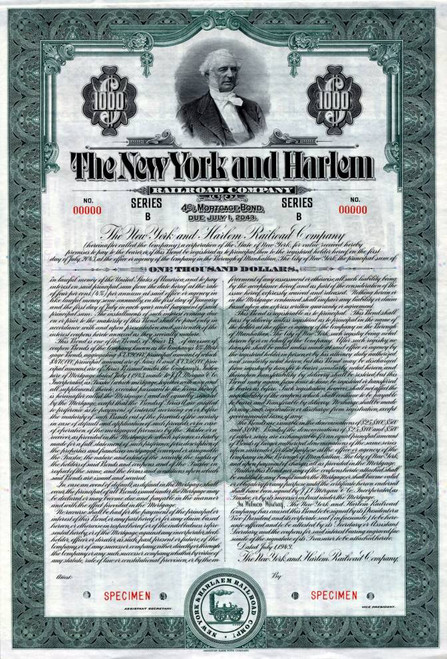New York, 1897, $100, 6% Income bond, Specimen, Black with eagle, POC's, Specimen Overprint, XF condition, ABNC. 10 coupons attached on right.

The Lotos Club is a private social club in New York City. Founded primarily by a young group of writers and critics in 1870 as a gentlemen's club, it has since begun accepting women as members. Mark Twain, an early member, called it the "Ace of Clubs". The Club took its name from the poem "The Lotos-Eaters" by Alfred, Lord Tennyson, which was then very popular. Lotos was thought to convey an idea of rest and harmony. Two lines from the poem were selected for the Club motto:
In the afternoon they came unto a land In which it seemed always afternoon
The Lotos Club has always had a literary and artistic bent, with the result that it has accumulated a noted collection of American paintings. Its "State Dinners" (1893 menu at right below) are legendary fetes for scholars, artists and sculptors, collectors and connoisseurs, writers and journalists, and politicians and diplomats. Elaborate souvenir menus are produced for these dinners.
The Lotos Club's first home was at Two Irving Place, north of 14th Street near the Academy of Music and on the site of the Consolidated Edison Building. Journalist DeWitt Van Buren was the Lotos Club's first president; he was succeeded by A. Oakey Hall. Dramatist and actor John Brougham was the Lotos Club's first vice president and he later became president of the club. Other early Club officers included Vice President F.A. Schwab, Secretary George Hows, and Treasurer Albert Weber. New York Tribune editor Whitelaw Reid was elected Club president in 1877, at which time the Lotos Club moved to 149 Fifth Avenue at 21st Street.
In 1893, the Club moved to 556-558 Fifth Avenue at 46th Street, purchasing their first clubhouse.
It was at the Lotos Club in 1906 that George Harvey, editor of Harper's Weekly, sent up his first trial balloon by proposing Woodrow Wilson for the office of President of the United States. In 1909, with financial backing from Andrew Carnegie, the clubhouse was moved to 110 West 57th Street, in a building designed by architect Donn Barber.
Frank R. Lawrence was the Club's longest serving president, from March 1889 until his death on October 26, 1918.Lawrence was succeeded as president by Chester S. Lord, who served for five years. In 1923, Columbia University president Nicholas Murray Butler was elected president of the Club.
The Club has a long history of showing the work of its artist members and has also held exhibitions of work from the collections of its members including one in 1910 that featured works by Degas, Monet, Renoir, Cassatt, and Hassam.[
In October 1941 the club held a mortgage-burning ceremony to mark payment of the $389,000 owed on the West 57th Street building. But in 1945 members began considering a move to a "simpler clubhouse."[6] The club has been housed since 1947 in a 1900 clubhouse designed by Richard Howland Hunt at 5 East 66th Street. The building had been commissioned by Margaret Louisa Vanderbilt Shepard as a gift for her daughter, Mrs. William Jay Schieffelin, in 1900.
In 1977, the Club amended its constitution to admit women.
History from Wikipedia and RM Smythe.








